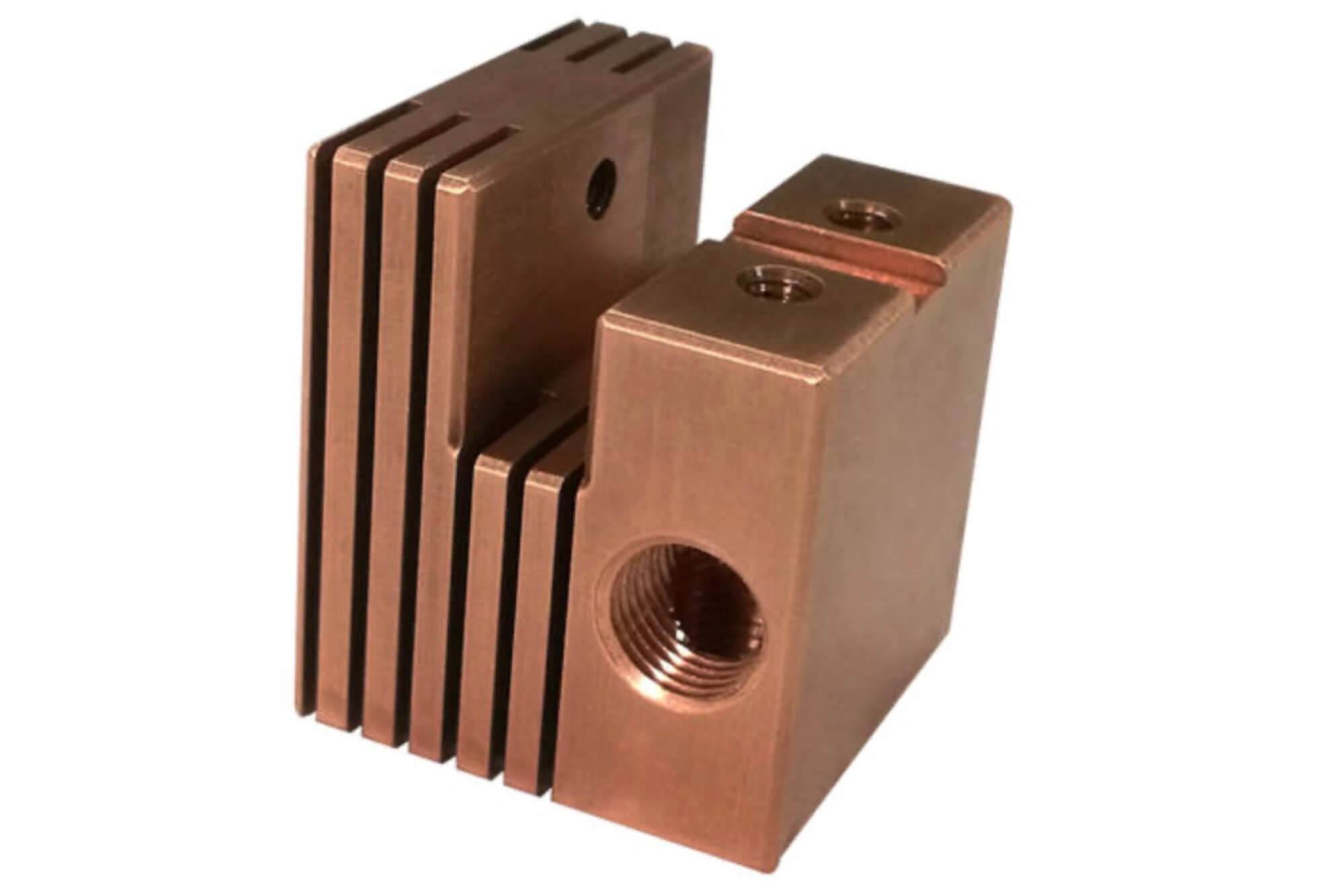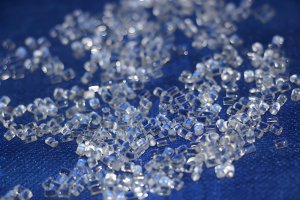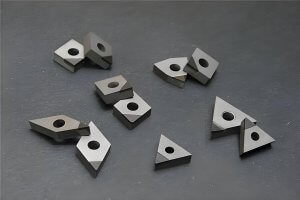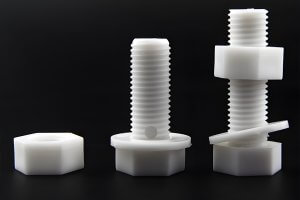Introduction
Red Brass is one of those materials you hear about a lot if you’re in machining or fabrication—especially if you deal with plumbing parts, marine components, or decorative pieces. But what exactly is it, and why do so many engineers and machinists choose it?
I first came across Red Brass while working on a custom valve body for a client in the HVAC industry. They needed something corrosion-resistant, easy to machine, and able to withstand high pressure. I was familiar with yellow brass and bronze, but Red Brass hit a sweet spot: the machinability of brass with some of the toughness of bronze.
What is Red Brass?
Red Brass is a copper alloy, typically containing around 85% copper, 5% tin, 5% lead, and 5% zinc. One of the most common grades is C83600, often referred to as “85-5-5-5” brass. There are other grades too, like C23000, which is sometimes called “Red Brass” in sheet or tube form.
The alloy has a warm reddish tint (hence the name), excellent corrosion resistance—especially in water—and is relatively easy to machine. For all these reasons, Red Brass shows up across various industries.
Why This Guide?
If you’ve ever tried machining copper alloys, you know not all of them behave the same. Red Brass is no exception. In this guide, I’ll share:
- What makes Red Brass special
- Which tools work best with it
- What machining parameters yield the best results
- Where Red Brass shines in industrial use
And I’ll include practical tables, machining advice, and real-world insight I’ve gained from actually working with this material.
Let’s get into it.
Material Overview
Red Brass might look like a pretty cousin of yellow brass, but don’t let that fool you. It’s got its own unique chemical makeup and performance profile.
Chemical Composition of Common Red Brass Grades
| Alloy Grade | Copper (Cu) | Tin (Sn) | Lead (Pb) | Zinc (Zn) | Typical Applications |
|---|---|---|---|---|---|
| C83600 | 84-86% | ~4.5-6% | ~4-6% | ~4-6% | Cast valve parts, fittings, pump bodies |
| C23000 | ~85% | — | — | ~15% | Sheet metal, tubes, architectural trims |
| C84400 | ~81% | ~10% | ~5% | ~4% | Plumbing parts, electrical components |
| C85700 | ~78% | ~6% | ~3% | ~13% | High-strength pump and valve parts |
This mix gives Red Brass excellent wear resistance, decent strength, and solid corrosion resistance in freshwater and mildly acidic environments.
Key Physical and Mechanical Properties
| Property | Value (C83600) |
|---|---|
| Density | 8.75 g/cm³ |
| Tensile Strength | 30,000–45,000 psi |
| Yield Strength | ~15,000 psi |
| Elongation | 15–30% |
| Brinell Hardness | 65–100 |
| Thermal Conductivity | ~78 W/m·K |
| Electrical Conductivity | ~22% IACS |
From a machinist’s point of view, this means:
- It cuts cleaner than pure copper
- It’s not as abrasive as some bronzes
- Tool wear is manageable with the right setup
I’ve used Red Brass when I needed something easier to machine than bronze but stronger than regular yellow brass. It fits nicely into that middle ground.
Red Brass vs. Other Copper Alloys
I once tried to replace Red Brass with a free-machining brass (C360) for a threaded pipe fitting project. While it did speed up production, the final product corroded way faster in a wet environment. That taught me something valuable—Red Brass may be slower to cut, but in the long run, it’s more durable in the right applications.
Applications in Industry
If you’ve been around fabrication, fluid systems, or even restoration work, chances are you’ve handled Red Brass without knowing it. I’ve used Red Brass in more than a dozen industries, and what stands out to me is how adaptable it is. Whether the job is structural, aesthetic, or functional, Red Brass consistently checks all the boxes.
Plumbing and Water Infrastructure
Red Brass is practically a staple in municipal plumbing. I’ve machined valve bodies, meter housings, and threaded couplers that ended up in city water systems. It’s preferred because it resists dezincification, especially in water with moderate mineral content. One project I remember involved a series of custom parts for a rural water district. We chose Red Brass for its ability to handle pressure while avoiding scale buildup. A few years later, the client told me those parts are still in use without corrosion or leakage.
Marine and Coastal Applications
Any metal exposed to saltwater needs to be tough and corrosion-resistant. Red Brass performs better than yellow brass or aluminum-bronze in most marine hardware. I’ve machined impellers, intake manifolds, and even anchor chain guides from Red Brass. It doesn’t crack under vibration and doesn’t degrade when submerged. In fact, one set of parts we delivered for a small harbor patrol boat is still in service after five years.
Architecture and Custom Fixtures
Architectural firms love Red Brass for custom hardware, not only for its corrosion resistance but also its unique color. When polished, it gives off a deep golden tone that looks more luxurious than yellow brass. I worked on a courthouse renovation where we needed to match 1930s hardware. Red Brass provided the right tone and machinability for reproducing ornate shapes.
Fire Protection Systems
Sprinkler heads, pressure relief valves, and system joints made from Red Brass can handle high-pressure systems while staying easy to thread and seal. A long-time fire equipment client of ours requests C83600 exclusively because other alloys failed pressure tests or were harder to machine. We’ve produced thousands of parts for them with practically no rework.
Electrical and Grounding Hardware
Red Brass offers decent electrical conductivity, especially when oxidation is minimized through surface finishing. I’ve used it to fabricate ground clamps and junction boxes that needed to survive outdoor environments. Unlike aluminum, which corrodes easily, and stainless steel, which is expensive and less conductive, Red Brass hits the sweet spot.
OEM, Machinery, and Tooling
Red Brass also appears in bushings, gears, and rotating parts that don’t require high load-bearing performance. What’s useful is that it’s stable across temperature swings. I’ve even machined custom jigs and temporary dies from leftover Red Brass bar stock—it’s just that reliable and predictable.
Cross-Industry Reference Table
| Industry | Application Components | Why Use Red Brass | Preferred Grade |
|---|---|---|---|
| Plumbing | Valve bodies, couplings, meters | Dezincification-resistant, good for threading | C83600 |
| Marine | Pumps, thru-hull fittings | Corrosion-resistant, handles vibration | C85700 |
| Architecture | Decorative handles, lighting bases | Polishes well, historic color match | C23000 |
| Fire Protection | Sprinkler heads, valve caps | Pressure-rated, threadable, castable | C84400 |
| Electrical | Terminal connectors, junctions | Good conductivity, weather stable | C83600 |
| Machinery | Bushings, housings, low-load gears | Machinable, affordable, thermally stable | C83600 |
Red Brass shows up where performance, appearance, and ease of machining matter. Whether I’m fabricating two pieces or 200, I’ve always been confident that Red Brass will machine cleanly, stay durable, and meet spec.
Machinability Analysis
Machining Red Brass is one of those tasks I always look forward to. It behaves predictably, doesn’t chew up tools, and gives me reliable results across turning, milling, drilling, and tapping. If you’ve ever machined bronze or pure copper, you’ll appreciate how Red Brass strikes a balance between the two.
Basic Performance Overview
Red Brass has a machinability rating of around 40–45% (relative to free-machining brass at 100%). That may sound low, but with the right approach, it’s incredibly workable. The lead in the alloy improves chip breaking and reduces tool wear. The tin improves strength and makes the surface smoother to cut.
The most immediate thing I notice is the smooth, non-sticky cut. It forms tight spiral chips, not long strands. Even when dry cutting for short jobs, it behaves well—but I always recommend coolant for finish-critical parts.
Tooling Setup That Works
Here’s what I’ve learned through trial and error:
- Use sharp carbide inserts with a slightly positive rake.
- Don’t skip on coolant, especially during drilling or tapping.
- For milling, 4-flute end mills give better finish than 2-flute at high RPMs.
- Always use peck drilling for holes deeper than 1.5x the drill diameter.
- For tapping, back out every few turns to clear chips—don’t try to power through like you might with aluminum.
Speeds, Feeds, and Depths
| Operation | Tool Type | Speed (SFM) | Feed Rate (IPR) | Depth of Cut (in) | Coolant | Notes |
|---|---|---|---|---|---|---|
| Turning | Carbide insert | 250–400 | 0.003–0.010 | 0.020–0.080 | Yes | Light DOC for clean finish |
| Milling | 4-flute carbide | 200–300 | 0.001–0.005 | 0.010–0.050 | Yes | Use climb milling |
| Drilling | HSS twist drill | 80–120 | 0.002–0.006 | — | Yes | Peck cycle recommended |
| Tapping | Spiral flute tap | — | — | — | Yes | Tapping fluid and chip clearing needed |
| Reaming | Solid carbide | 50–100 | 0.001–0.003 | — | Yes | Precision holding fixture helps |
Surface Quality and Tool Life
When I’m doing finishing passes, I usually aim for:
- Feed: 0.0015–0.002 IPR
- DOC: <0.010”
- Coolant: Flood or high-pressure
This consistently yields 16–32 µin Ra surface finishes. For polished parts, I’ll hit them with a red compound buff for a mirror-like glow.
Tool life is surprisingly good. I typically get 150–250 parts per insert edge with consistent conditions. In one job involving low-speed threading of 1.25” Red Brass fittings, we got 300+ threads per HSS tap before it showed signs of wear.
Mistakes to Avoid
Let me save you some scrap:
- Don’t dry-tap Red Brass. It will gall even with lead content.
- Avoid aggressive DOC. Red Brass doesn’t respond well to brute force.
- Dull tools smear the surface. Always use sharp inserts.
- Negative rake tools increase tool pressure and shorten tool life.
Final Thoughts on Machining Red Brass
Out of all the copper alloys I’ve worked with, Red Brass offers the most consistent machining experience. It doesn’t warp from heat, doesn’t clog up tooling, and behaves predictably under different setups. That’s exactly what I want in a material when I’m on a deadline—or when rework is expensive.
Case Studies
I’ve machined a wide variety of metals in my career, but Red Brass always stands out for how reliable it is across different types of jobs. In this section, I want to walk you through a few real machining jobs I’ve completed using Red Brass—each with different goals, challenges, and lessons.
Project 1: CNC Machining of Fire Valve Bodies
This was a production job for a fire suppression equipment manufacturer. They needed a run of 400 threaded valve bodies machined from C83600 Red Brass.It is a project about CNC machining.
Specs:
- Part size: 2.75″ diameter, 3.25″ length
- Tolerance: ±0.002″
- Internal threading: 1.5″ NPT
- Surface finish: <32 µin Ra
Setup:
- Lathe: Haas ST-20Y
- Insert: CNMG 432, positive rake, PVD coated
- Coolant: Flood
- RPM: 1100
- Feed rate: 0.006 IPR
- DOC (finishing): 0.015″
We rough cut with a 0.06” DOC and then took two finish passes. For threading, we used a spiral flute tap with synthetic tapping fluid. One tap lasted around 160 threads before chipping. Parts passed pressure testing at 300 psi with no leaks or galling.
Lessons:
- Always use tapping fluid—even for soft alloys like Red Brass
- Clean internal threads with a nylon brush to remove lead oxide dust
- Surface finish improved drastically with slightly lower RPM on the final pass
Project 2: Custom Marine Water Intake Flanges
A marine engineering firm commissioned 24 custom flanges made from Red Brass C85700 for their new prototype catamaran. These parts had to handle saltwater exposure, vibration, and constant temperature changes.
Specs:
- OD: 4″
- ID: 2.25″
- Hole pattern: 6x M8 tapped through
- Flatness tolerance: <0.005″
- Finish: Machined only, no coating
Setup:
- Mill: Tormach 1100MX
- Tool: 3-flute carbide end mill, ¼”
- Coolant: Mist
- RPM: 3200
- Feed: 20 IPM
- DOC: 0.030″ (finishing), 0.080″ (roughing)
For tapping, we switched to a semi-automatic tapping arm. The operator was instructed to pull back every 1.5 turns. Results were excellent. I personally test-installed two flanges using gaskets and stainless bolts—no misalignment, no burrs, and perfect mating.
Lessons:
- Red Brass handles high-speed milling better than expected
- Misting coolant is enough if feed rates are conservative
- Tapping fatigue can be avoided with proper ergonomics
Project 3: Custom Heritage Door Handles
This was a small but satisfying job—recreating a pair of Red Brass door handles for a vintage hotel. The original fixtures were from the 1920s, tarnished and worn.
Specs:
- Profile: Ornate curve, 3D contouring
- Surface: Fully polished, no visible machining marks
- Quantity: 2 pieces
Process:
- Material: C23000 Red Brass (sheet stock)
- CAM software: Fusion 360
- Toolpath: Parallel finishing, 0.002″ stepover
- Polishing: Tripoli + red rouge compound
Each handle took 7.5 hours to machine and another 2 hours to hand-polish. But the result? Absolutely stunning. The client was thrilled, and we were proud to be part of a historic restoration.
Lessons:
- For aesthetic parts, low stepover is worth the extra time
- Red Brass polishes beautifully—but needs fine prep to shine
- CAM programming for soft contours is critical to avoid visible “steps”
Processing Techniques
Machining Red Brass is only part of the equation. How you handle it before and after the cut has a major impact on performance, appearance, and customer satisfaction. In this section, I’ll walk you through processing techniques that I use from start to finish.
Cutting and Blank Prep
Before a single chip flies, you need to prep your blanks. Red Brass bar stock can be gummy if the saw blade is dull or feed rate is too high. I recommend:
- Bandsaw blade: 6–10 TPI bimetal
- Coolant: Flood or wax stick
- Feed: 1–1.5 IPM
- Secure with V-block to prevent chatter
Always deburr immediately after cutting—Red Brass tends to leave razor-sharp edges.
Turning and Milling Techniques
The most important thing with Red Brass is control. This alloy doesn’t like brute force.
- Always enter the cut cleanly—no plunging into full stock width
- Use light finishing passes (under 0.015” DOC) to avoid tearing
- Chamfers should be shallow; deep chamfers tend to fray edges
Drilling and Tapping Techniques
When drilling Red Brass:
- Use sharp cobalt drills with 135° split points
- Always spot-drill for accuracy
- Use pecking cycles with air blast or coolant
For tapping:
- Use spiral point taps for through-holes
- Use spiral flute taps for blind holes
- Keep threads clean—lead oxide dust builds up fast
Surface Treatments
Red Brass can be finished in several ways, depending on its purpose:
| Treatment Method | Purpose | Recommendation for Red Brass |
|---|---|---|
| Polishing | Visual enhancement | Use fine abrasive, then red rouge |
| Lacquering | Oxidation protection | Only for decorative parts, not functional ones |
| Passivation | Corrosion resistance | Rarely needed, but optional in marine uses |
| Electroplating | Color or conductivity control | Brass-on-brass plating can create aesthetic depth |
One thing I’ve found is that Red Brass does develop a patina over time if left untreated. Some clients love this—especially for antique or heritage applications. Others want the “golden glow” preserved, so polishing and clear-coating is a must.
Storage and Handling
Red Brass is softer than steel but harder than pure copper. I store raw material on wooden racks to avoid scratches. Machined parts are stored in sealed plastic bins with desiccant to prevent oxidation.
For international shipping, especially overseas or coastal regions, we also apply a light oil film and wrap parts in anti-corrosive paper.
Red Brass vs. Other Alloys
One of the most common questions I get—especially from new clients—is: “Why Red Brass? Wouldn’t yellow brass or bronze work just as well?” And I get it. When you’re picking a copper alloy, there are dozens of options. So in this chapter, I’ll walk you through how Red Brass compares to other popular materials in real machining and usage conditions.
Red Brass vs. Yellow Brass
Yellow brass (like C360 or C377) is cheaper and easier to machine. It’s widely used in mass-produced plumbing parts and fittings. But here’s the catch: it corrodes faster in water systems, and it’s not suitable for high-pressure or marine environments.
From a machining perspective:
- Yellow brass machines faster and is more forgiving on dull tools.
- Red Brass takes more care but produces a better finish and less tool vibration.
- In pressure applications, Red Brass wins hands down.
I’ve had clients who tried switching to yellow brass to save cost but came back after failures in service—especially in outdoor or marine use. That lesson usually only needs to be learned once.
Red Brass vs. Bronze
Bronze (like C932 or C954) is harder, stronger, and more wear-resistant than Red Brass. It’s great for bushings and load-bearing parts. But it’s tough on tools and more expensive.
When I’m machining large runs, bronze leads to:
- More frequent tool changes
- Higher power requirements
- Rougher surface finishes unless polishing is added
Red Brass fills a nice niche between yellow brass and bronze—it’s stronger than yellow brass, easier to machine than bronze, and corrosion-resistant enough for most mid-stress applications.
Red Brass vs. Pure Copper
Pure copper is soft, sticky, and hard to machine. It smears instead of cutting cleanly, and it oxidizes very quickly.
Compared to copper:
- Red Brass machines cleaner
- Holds dimensions better
- Doesn’t require cryogenic or lubricated tooling for every cut
I only recommend pure copper when maximum electrical conductivity is required. For structural or fluid systems, Red Brass is the better all-around choice.
Red Brass vs. Stainless Steel
This one comes up more than you’d think. Stainless is corrosion-resistant, yes, but it’s also:
- Harder to machine
- Heavier
- More prone to galling
Unless you’re dealing with extreme temperatures or chemical resistance needs, Red Brass often gives you 80% of the performance at half the machining cost.
Summary Comparison Table
| Property | Red Brass | Yellow Brass | Bronze | Pure Copper | Stainless Steel |
|---|---|---|---|---|---|
| Machinability | Moderate | High | Low | Very low | Low |
| Corrosion Resistance | High | Medium | High | Medium | Very high |
| Strength | Moderate | Moderate | High | Low | High |
| Cost | Moderate | Low | High | Moderate | High |
| Surface Finish | Good | Good | Fair | Poor | Fair |
| Threading Ease | High | High | Low | Low | Low |
My general rule is this:
If I need strength + machinability + corrosion resistance, I reach for Red Brass. It’s never the cheapest, but it performs better than expected in 80% of real-world applications.
Procurement and Selection Guide
When it comes to buying Red Brass, I’ve learned that not all suppliers—or alloys—are created equal. I’ve worked with enough distributors, fabricators, and casting houses to spot the red flags. Here’s everything you should consider when sourcing Red Brass for machining.
Know the Grades
The term “Red Brass” isn’t a single alloy—it covers several grades depending on the use case.
| Grade | Copper (%) | Tin (%) | Lead (%) | Zinc (%) | Common Use Case |
|---|---|---|---|---|---|
| C83600 | ~85 | ~5 | ~5 | ~5 | Valves, cast parts, general purpose |
| C84400 | ~81 | ~10 | ~5 | ~4 | Plumbing, pressure fittings |
| C23000 | ~85 | — | — | ~15 | Sheet metal, decorative parts |
| C85700 | ~78 | ~6 | ~3 | ~13 | Marine valves, structural parts |
When I’m ordering stock for machining, I usually go with C83600—it offers the best combination of castability, machinability, and mechanical stability. C23000 is best when I need flat sheet or tube for forming or laser cutting.
Raw Material Forms
Red Brass is available in:
- Round bar (common for machining)
- Hollow tube
- Flat bar
- Cast billets or ingots
- Sheet and plate
Make sure your supplier understands tolerance and surface quality. I once received a batch of 2” bars with saw-cut ends that weren’t square—lost a full day on cleanup passes. Now I always request facing at both ends if I’m doing precision turning.
Supplier Questions to Ask
Before placing a PO, I always ask:
- What exact alloy and spec are you shipping?
- Is it certified to ASTM (e.g., B62 for C83600)?
- What’s the country of origin and mill certificate date?
- Can I get test coupons with mechanical properties?
- Has the material been heat-treated or stress-relieved?
Some overseas material lacks consistent metallurgical properties. If you’re working in aerospace, defense, or fluid control systems, these questions matter.
Cost Considerations
Red Brass pricing depends on:
- Copper market price (usually the main driver)
- Lead and tin content (adds cost)
- Whether it’s virgin or recycled material
I’ve seen price swings of up to 20% year over year. To hedge against fluctuations, some of my clients place quarterly standing orders. That guarantees availability and stabilizes budgeting.
Storage and Inventory
Red Brass tarnishes over time, especially in humid storage rooms. I recommend:
- Wrapping with VCI paper
- Keeping material in sealed bins
- Applying a light oil film on raw bars
Finished parts should be stored in padded containers—Red Brass is softer than you think, and scratches show easily on polished surfaces.
Sourcing Recommendations
If you’re in North America, here are a few suppliers I’ve had good results with:
- Aviva Metals – full selection of Red Brass grades
- Sequoia Brass & Copper – small runs and fast lead times
- Farwest Steel – regional supply, mostly West Coast
If you’re running a long-term job, ask about heat lot consistency—nothing throws off toolpaths like small metallurgical changes in mid-batch.
FAQ
Here are the most common questions I’ve received over the years about machining and using Red Brass. If you’re searching for hands-on advice or real answers—not just textbook definitions—you’re in the right place.
1. What is Red Brass made of?
Red Brass typically consists of about 85% copper, plus smaller amounts of tin, lead, and zinc. The most common machining grade is C83600, which contains 5% each of tin, lead, and zinc.
2. How is Red Brass different from yellow brass?
Yellow brass contains more zinc and no tin, making it cheaper and easier to machine but less corrosion-resistant. Red Brass is better for plumbing, marine, and high-pressure applications.
3. Can I machine Red Brass with standard tools?
Yes. I use standard carbide and HSS tools with great results. Just make sure they’re sharp, and use light DOC to avoid smearing.
4. Does Red Brass need coolant when machining?
Technically no, but I always recommend coolant for better finish, chip evacuation, and tool life. Even a mist system helps.
5. Is Red Brass suitable for CNC turning and milling
Absolutely. I’ve run thousands of parts on both lathes and mills. Red Brass holds tolerances well and doesn’t deform under tool pressure.
6. What surface finish can I achieve on Red Brass?
With sharp tools and proper feeds, I often get 16–32 µin Ra finishes. Polishing can take it down to mirror levels.
7. Does Red Brass oxidize or tarnish over time?
Yes, it develops a brownish patina, especially in humid conditions. You can prevent this with clear lacquer or light oil film.
8. Is Red Brass safe for drinking water applications?
It depends on the grade. Some grades contain lead, so always check RoHS compliance and regional plumbing codes.
9. How strong is Red Brass compared to bronze
Red Brass is softer and less wear-resistant than bronze, but it’s easier to machine. For pressure and corrosion resistance, it’s a solid middle-ground material.
10. Can Red Brass be welded?
Generally no. The lead content causes outgassing and weak welds. Use brazing or mechanical fastening instead.
11. What kind of tapping fluid should I use?
For Red Brass, I use a light synthetic or oil-based fluid. This keeps threads sharp and prevents galling.
12. How should I store Red Brass stock and parts?
Keep it dry, sealed, and preferably in anti-corrosion wrapping. Polished parts should be padded to avoid scratches.
13. What is the machinability rating of Red Brass?
Roughly 40–45%, compared to C360 free-machining brass at 100%. That’s good enough for clean cuts with the right parameters.
14. Where can I buy Red Brass for machining?
I use suppliers like Aviva Metals, Sequoia Brass, or local metal service centers. Always ask for mill certs and exact alloy specs.
15. Can Red Brass be used outdoors?
Yes. It handles moisture and weather better than yellow brass. I’ve used it for lighting fixtures, railing caps, and marine parts.
16. What are common uses of Red Brass in industry?
Valves, pumps, architectural fixtures, electrical connectors, marine hardware—you name it. It’s extremely versatile.
17. Is Red Brass more expensive than other brasses?
Usually, yes. The higher copper and tin content raises the price. But the value it offers in corrosion resistance and machinability often offsets the cost.
18. Can Red Brass be anodized or plated?
It can’t be anodized like aluminum, but plating (e.g., nickel, chrome, or gold) is possible. Just ensure the surface is clean and oxide-free.
Authoritative References on Red Brass
- MatWeb – C83600 Leaded Red Brass Alloy Data Sheet
This comprehensive datasheet outlines the chemical composition, mechanical properties, and typical applications of C83600 Red Brass, commonly used in valves, flanges, and pump components.
🔗 https://www.matweb.com/search/datasheet_print.aspx?matguid=3ad1def0a06e4448950f30c9ec120e99 - Copper Development Association – Red Brass/Gunmetals
This resource discusses the use of Red Brass (also known as gunmetal) in marine applications, highlighting its resistance to corrosion from steam and saltwater, and its immunity to dezincification.
🔗 https://copper.org/applications/marine/other-copper-alloys/brasses/red-brass-gunmetals.php - AZoM – UNS C23000 Red Brass Alloy Information
Provides detailed information on the properties of UNS C23000 Red Brass, including its machinability, hot and cold working capacities, and common applications in electrical components and decorative hardware.
🔗 https://www.azom.com/article.aspx?ArticleID=6338 - Concast Metal Products – C83600 Alloy Profile
Offers insights into the applications and characteristics of C83600 Leaded Red Brass, emphasizing its use in plumbing and its excellent machinability.
🔗 https://www.concast.com/c83600.php - MatWeb – C84400 Leaded Semi-Red Brass Data Sheet
Details the composition and properties of C84400, a semi-red brass alloy, commonly utilized in plumbing applications due to its good casting and machining characteristics.
🔗 https://www.matweb.com/search/DataSheet.aspx?MatGUID=a80cf3ff700e4364a32bcb4a1a684e12 - AZoM – Silicon Red Brass UNS C69400 Overview
Explores the mechanical and thermal properties of UNS C69400 Silicon Red Brass, including its machinability and suitability for various fabrication processes.
🔗 https://www.azom.com/article.aspx?ArticleID=6455
Other Articles You Might Enjoy
- Brass Screws Custom Machining Guide: Techniques, Tools, and Best Practices
Introduction Brass screws are among the most popular fasteners used across various industries due to their unique combination of aesthetics, corrosion resistance, and excellent machinability. If you're considering CNC machining…
- What Is a Brass Nipple? Full Guide to Types, Threads, Custom and CNC Machining
I’ve been working with brass fittings for years, and one of the most common questions I get is, “What exactly is a brass nipple, and why is it such a…
- Brass vs Gold for Jewelry, Fixtures, and Electronics Etc: Pros and Cons
Introduction: Why Compare Brass and Gold? If you’ve ever shopped for jewelry, home decor, or electronic components, you’ve probably faced the question of brass vs gold. On the surface, these…
- Brass Pipe Customization via CNC: What Engineers and Buyers Must Consider
Introduction: Why Brass Pipe Matters in CNC Projects Brass pipe is one of those materials engineers and buyers often overlook until they face a challenge only brass can solve. Early…
- Brass Bushings Explained: Machining Tips, Tolerances, and Use Cases
Introduction: Why Brass Bushings? I remember the first time I truly understood why brass bushings mattered so much in mechanical setups.I was standing in a small workshop, looking at the inner components…
- Brass vs Copper: The Ultimate Guide for Manufacturers and Machinists
Chapter 1: Introduction I’m excited to share my ultimate comparison of brass vs copper for manufacturers and machinists. Having worked with both materials in various machining and manufacturing environments, I know how…
- Copper Custom Innovations: Exploring New Alloys and Hybrid Manufacturing
I’ve spent a significant amount of time exploring various manufacturing processes, and one of the most intriguing areas I’ve encountered is what I call “Copper Custom.” This term encapsulates the…
- CNC for Copper Pipe: Revolutionizing the Efficiency and Precision of Copper Pipe Processing
How CNC Technology Plays a Vital Role in Copper Pipe Processing Copper pipes are indispensable across multiple industries, from plumbing and HVAC systems to automotive and medical applications. However, achieving…






